
 |
If it wasn't for a comet I would never been interested in the night sky, it's awesome how quickly the path of someone's life can be altered permanently by one single sighting. For me that happened during the pre-dawn hours of Spring 1997 when Brendan Bradley and I looked towards the E, and there, perched above the dark outline of the tree tops, and aloft over the sparkling frost, was what I can only describe as a ghostly apparition. This bizarre thing in the sky shocked us, it had a fuzzy bright head and a vivid search light extending up from it, I thought at first it was a powerful light mounted on a pole, but there was no pole, I even thought it could have been a UFO, it was neither, it turned out to be great comet Hale-Bopp.
This was my first ever sighting of a comet and I had witnessed it completely by accident through virgin eyes. Nobody had told me it was there, I didn't watch the news, I never really looked up at the night sky before, now that had changed. I was powerfully affected by this observation, to me it looked like something alien, like it shouldn't have been there, a visitor interrupting the stars, I was hooked. During that pre-dawn catch up with a friend the course of my destiny changed abruptly and life would never be the same again.
I ended up getting into Astronomy and it wasn't long before I stumbled across a book, by accident yet again, in the local library called 'The Sky A User's Guide' by David H. Levy. The section on comets and his first discovery blew my mind, I never knew there where other comets to find and I never knew that amateur Astronomers searched for them and could discover a comet all of their own, and furthermore it even got named after the discoverer, this was engaging stuff and my new found passion burned deeply. I made it my life's goal to observe as many comets as possible, to witness another great comet and to try and a discover a comet of my own. Over the years I have since observed 94 comets and devoted over 1300 hours searching for new comets, so you could say this field is close to my heart.
If a new comet is discovered with the prospect of becoming bright the build up and hunt to observe it completely takes over my life, it feels like a calling, yet I know it's all connected with Hale-Bopp. The emotions a comet's tail conjures up within brings me back to that great visitor in 1997, a combination of being in awe yet somewhat frightened by it's appearance, I can understand why the ancients feared them and associated comets with war and famine and everything else they could blame them on. There's something about a comet, they just don't seem to belong in the starry night sky which we are so familiar with, they appear, they impress, and they are gone again just as fast.
In the northern hemisphere great comets have been in short supply, there have been none since 1997, we did see a selection of nice binocular and faint naked eye comets over the years, the most recent being C/2020 F3 NEOWISE, which I still consider to be one of the most beautiful natural phenomena I've ever seen in my life, that was a beautiful comet. Then three years later during January 2023 a new distant comet was detected by the Purple Mountain Observatory in China and ATLAS in S. Africa, it was officially designated C/2023 A3 Tsuchinshan-ATLAS. At almost mag +19 it was a faint object, at first mistaken for an asteroid until follow up observations confirmed its cometary nature. Then the orbit was calculated, the comet would make a close approach to the sun on September 27th 2024 at the same distance as planet Mercury then swing around the sun and make a post-perihelion performance as it past the Earth, the prospects were encouraging of a bright comet on the way.
My obsession began immediately, I was literally counting down the days since its announcement, I couldn't wait and I was already starting to plan where to go, I new I just needed a good W-SW horizon and clear skies, the latter would become the subject of much anxiety later on. Arguments began rite away in comet circles regarding the comet's future, some said it would do what many fresh Oort Cloud comets do, bright at discovery then slow down later as its layer of volatile material is burned off by solar heating and under performs. The other outlook was complete disintegration, this is always a concern, every comet is different, some are fairly solid yet others are porous bodies and yet others are icy rubble piles loosely held together by their own mutual gravity. The negative voices had crawled out of the shadows early proclaiming this would be yet another damp squib.
First Sighting
I paid them little heed, as a matter of fact I had a very good feeling about this comet, I just knew it was going to perform, in fact, I was one of the few people who posted regular updates about it on social media documenting it's entire apparition. I wanted to see it myself, I needed to catch it when it was faint so that when I did see the comet at it's best I would have a memory to compare it with. Time would soon be running out before it was lost in solar glare during May so I packed up the telescope and on the next clear night I hit the road on the hunt for this comet, it would be the first of many hunts to come.
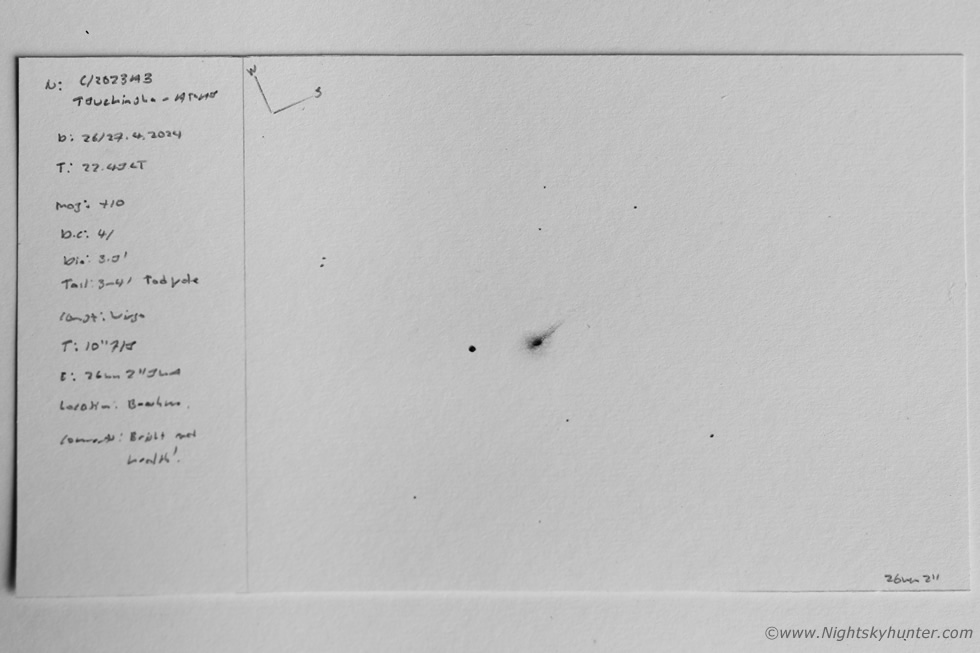 |
I drove along the dark roads in the Sperrins and pulled into a picnic area near Beaghmore Stone Circles, I set up the 10" F5 reflector, got dark adapted, and began sweeping through the constellation of Virgo. Not far from a naked eye star was a faint fuzzy patch of light, it was the comet, oval in shape, with a bright condensation at centre. With a averted vision a slender short tail could be seen, like that of a tad pole, I was delighted, I had spotted T-A and knew it had a bright future and looked forward to seeing it in six months time, hopefully without a telescope. The moon became bright washing it from view and the comet itself got lower and lost in solar glare.
The Emotional Roller Coaster Ride Begins
Then the negative voices raised their heads again. A serious comet scientist produced a paper that stated with great confidence 'The Imminent Demise Of Comet C/2023 A3' and in it he made the case that not only was the comet going to fall apart but that it was actually a boulder field, this explained the comet's slow down in brightness around this time, in other words the comet was falling apart and we would have no bright comet to enjoy. This was devastating news, I was in utter shock, how could this be the case? first ISON fell apart then another comet ATLAS fell apart, both of those were meant to be great comets, and now T-A as well, it seemed the northern hemisphere was cursed again.
Yet something didn't quite add up, I wasn't buying it, then much to my delight other experts came out to dispute this paper. CCD images showed a healthy coma with no sign of disintegration and furthermore a green ion tail had developed alongside the dust tail, this wouldn't be happening with a dying comet. It seemed that positivity was wining over the negativity, telescopic observations revealed the comet was producing very high concentrations of dust and the nucleus was estimated at 2.3km in diameter, it was too large and above the Bortle Survival Limit and was unlikely to fall apart, the tables had turned. The slow down in brightness was caused by phase angle effects at opposition, it wasn't intrinsic, it was simple viewing geometry and once this phase angle changed the comet was back on track again and back in line with the light curve, it was game time.
During all of this I was having private conversations with Chris Wyatt and Alan Hale and even a brief exchange from David Levy, all of whom were extremely optimistic about the comet. Alan was convinced it was going to put on a show in October, there was no doubt in their minds this was happening.
The Show Begins
C/2023 A3 began putting on a show as it approached perihelion, however it was only best seen from the southern hemisphere and for those just north of the equator. Spectacular images appeared showing a dust tail 15 degrees long, then 20 degrees visually, there were even images showing the tail extending much longer than this. Social media was full of images every day and I took it all in with a building sense of awe. It was around this time that I became truly obsessed with this comet, it was only two weeks away from appearing in our skies, this was what I had been thinking about on a daily bases for 17 months and it was almost show time. I knew it was going to perform however I also began feeling daily anxiety over the weather forecast, our biggest enemy here in the UK. There was a slight chance I might see it before perihelion in the pre-dawn sky and this is when the hunt began for real.
Pre-Dawn Comet Hunting
Charts indicated the comet was low along the E-SE horizon before sunrise from the northern hemisphere, so low most people wouldn't even bother trying. On September 24th/25th at 05.30 I got up early, packed the telescope, and drove to an elevated position on Slieve Gallion which offered a superb view to the E. The comet would only be 2 degrees above the horizon and within intense twilight, I figured I might be able to pull it out from the sky with the telescope and perhaps the long tail might be extending upward. The night was perfectly clear with excellent transparency, I observed several Messier objects to pass the time and got my camera ready. I saw something out the corner of my eye, pale beams of light to the NE like transparent pillars, it was the aurora!, that was a nice surprise, it's been a while seen I observed the aurora at 06.00 in the morning.
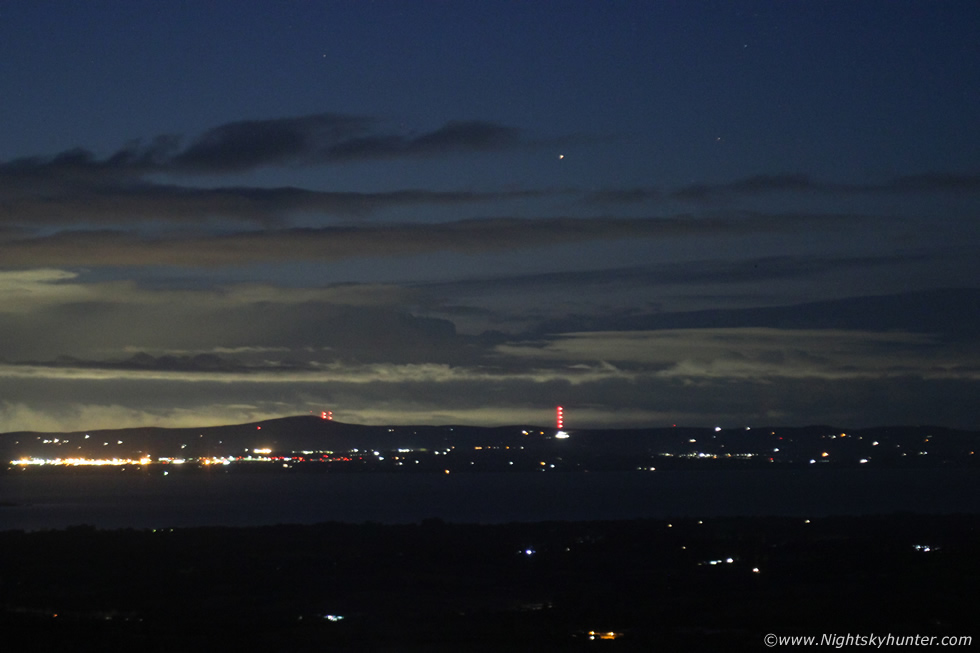 |
I turned my attention back to the comet, the sky was clear except for one strip of cloud taking up 5 degrees of the horizon. I swept with the telescope above the cloud, around it, between clouds, but nothing, I picked up a few stars but nothing else. The comet was located within Sextans far below Leo and SE of the naked eye star Alphard. The background sky then become so bright it was impossible to see anything, I was searching so low I could see the hills of Belfast, Divis, and its red lights, and planes taking off from the airport passing through the field. After 07.00 I called off the search, that cloud hid it from me but I wondered would I have seen it anyway that close to the sun, after all it was mag +2. I decided I would make one more effort and if that didn't work out then all my energy would be focused on the evening show.
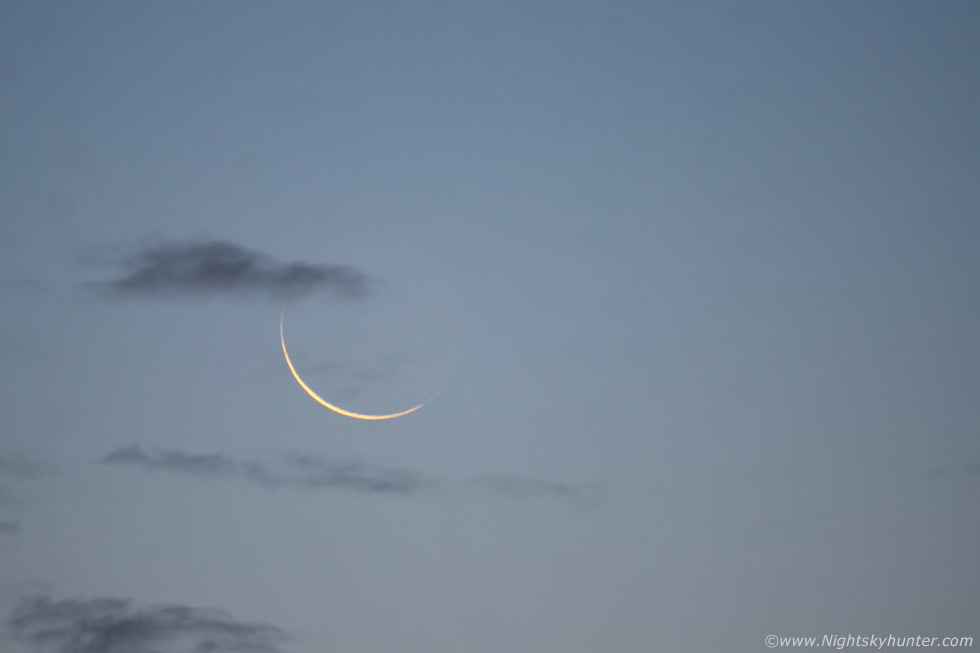 |
On September 31st I was out again, this time from 04.45 to 07.30, back to the top of Slieve Gallion. I had the camera with long lens taking telephoto patrol images combined with visual sweeps with the telescope. I had some good clear breaks but once again the comet was behind cloud, and being just shy of 4 degrees high it was not likely to happen anyway, but it was a good effort. I actually did a search for new comets for a while though Hydra and Leo and southern Cancer, I picked up a few NGC galaxies and several star clusters, always time well spent. I didn't come home empty handed though, this gorgeous slender crescent moon which was gold in colour appeared between the clouds before sunrise.
Daylight Attempts
C/2023 A3 began to brighten rapidly. It appeared within SOHO's LASCO C3 camera with a huge tail filling the entire field. Forward scattering caused the comet's brightness to surge by a factor of 700 or even 800 times and as a result it peaked at mag -3 to -4 at an elongation of only 4 degrees from the sun. This was the brightest comet in SOHO since McNaught in 2007. Some observers managed to capture it in broad daylight on camera by stacking images, a few others seen it in binoculars. On October 7th, 9th and 10th I conducted daylight searches using my eyes, a 100mm lens and my telescope, I hadn't done this in years, other daylight attempts in the past were McNaught, V1 NEAT and F4 Bradfield.
Unfortunately I never seen the comet in daylight so I have yet to tick this off my dream list. I blocked the sun with trees, lamp posts, the side of a house and searched the adjacent areas, however there always seemed to be subtle cirrus in the area, I was glad to have tried for it anyway, we had plenty of glorious clear skies during this time. On the days ahead the comet moved N from the sun and began to appear low in the W-SW evening sky, this was what I had been waiting for.
So Close....And Epic Aurora
My first serious attempt to find the comet was on October 10th/11th, my plan was to walk to the top of Tullyhogue Fort outside Cookstown. This would be an exciting day for other reasons. A fast moving CME from an X-class flare had hit the Earth at 17.00 and a severe geomagnetic storm was in progress, if the Bz stayed S we could be getting an epic aurora soon after dark. I had already planned to meet the guys at Lough Fea which offered the best chance of clear skies but first I wanted to find the comet.
 |
Roisin, Rhua and I walked to the top of the fort. It was a cold day however the clarity was exceptional, then I waited and watched the sun set over a perfect horizon. The view was exceptional for the comet which was very low on the horizon, perhaps 10 degrees at most soon after sunset. I had borrowed a pair of 10x42mm binos from my Dad which I used to scan the sky while taking random images with the long lens. Unfortunately there was too much cloud on the horizon this time but I felt encouraged by the location, I would try from here again.
I raced home, got some supplies then met the guys at Lough Fea, I will save the details for another website report, but in a nutshell we got treated to a remarkable aurora. It was the stuff of dreams, simply beyond description, one of the stand out aurora events of our lives. This was a fantastic treat and a much welcomed distraction from the comet for a few hours. All of us were affected emotionally, that half hour period after midnight will be talked about for the rest of our lives. We were buzzing for days, all we needed now was to see this comet and this would be a remarkable month.
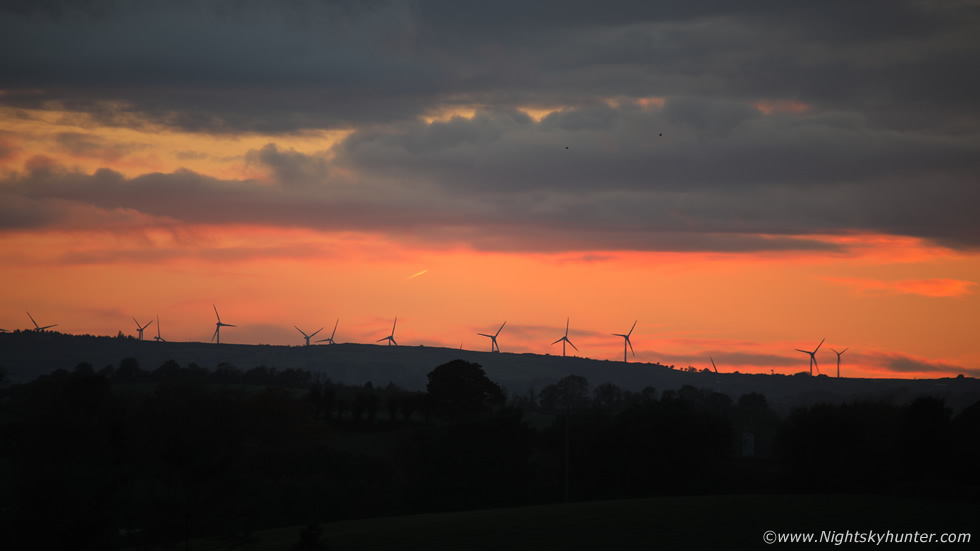 |
On October 12th/13th I went back to Tullyhogue Fort, it had been clear all day with a cold air mass so I was feeling very positive about catching the comet this evening. From the fort I had camera set-up and binoculars out, the wind was brutal, not so much it's strength but its chill, it cut rite through me and it wasn't long before I was very cold. My fingers began to get so cold it was difficult to adjust the tripod head all the time, touching metal was not a nice feeling. Then a row of dark shower clouds crossed the W sky, I managed to spy Venus with the binos but the clouds and rain streaks falling down hid the comet from me again. I took countless images, searched the skies, absolutely nothing, soon the comet would be setting and those showers where in the wrong place. No joy again, I began walking back down to the car park feeling defeated, was I ever going to see this comet?
Then I got a call from John Fagan, he was observing from Dungannon and he informed me with great joy that he had just found it. He literally rang me immediately after seeing it, he was so excited, he found it to the far lower left of Arcturus. It looked like a bright fuzzy star and he even could see part of the tail. I was overjoyed for John, genuinely so happy to hear he had found it, he is as fascinated by comets as I am. This was very encouraging news, a positive sighting from N. Ireland and he got it on camera too, this was now the start of it. I began to wonder though when my time would come?
Chronicles Of The Sperrins
While all of this was going on I was also working in the background with a BBC TV crew who have made a highly successful series focused on various parts of N. Ireland, such as Armagh, Belfast etc. The producer is currently making a second series focused on the Sperrins called Chronicles of the Sperrins. This is a four part series focused on all four seasons of the year following different people who have unusual jobs or hobbies. I was invited to take part and over the course of this year we have been filming for the show. First was the major aurora of May 10th for the Spring episode, the June 26th NLCs will be the Summer feature, and now comet C/2023 A3 will be the Autumn highlight.
The crew called to the house on October 11th, I hardly had any sleep from the major aurora the night before but I was on such a high I felt sharp anyway. We had a nice filming session from my back garden which I really enjoyed. It was a glorious sunny day with perfect blue skies. Veronica and Matt (the cameraman) got to work filming me setting up the telescope, making adjustments, then a contemplative moment when I was asked to sit on the back steps and talk about the sky, my first sighting of Hale-Bopp, and a rare moment when I got to showcase my observing log books, especially sketches of the planets and of comets, this was a special moment for me, those log books go back to 1998 and document my entire life under the sky, it was moving for me to have them featured. The daylight behind the scenes filming was complete, now the rest was up to me, the comet, and the weather.
20 Degree Naked Eye Tail!
I have to be honest with you, sometimes I get very excited when rare and dramatic transient events happen in the sky, I become quite emotionally invested, sometimes I work myself up, but that's just the way I am. I've always had this strong connection with the sky however controlling that energy can sometimes be problematic. I had anticipated this comet for so long and thinking about it so often that I had worked myself into a bit of a state. My mental focus and intensity was starting to affect me physically. I couldn't sleep at night, every night, I would go to bed thinking about the comet then drift off into a semi sleep, then wake up at 4am and think about it again. I would end up spending several hours researching it online until I finally fell asleep with exhaustion, and this was happening to me every night. Nothing else mattered only seeing this comet, the tension began affecting my stomach and I began having digestive problems and these symptoms only increased in magnitude on the days running up to the comet's appearance, I was tightly wound up, Roisin knew I was obsessing and prayed that I would get to see it so I would stop torturing myself.
On October 14th I was almost at the breaking point, how much longer did I have to wait? and the long term forecast looked dodgy but I couldn't even go there in my mind. On this particular night there was a slight chance of spotting it, however my confidence levels were extremely low. The models were showing some clear spells but also high cloud moving in around sunset, in my mind I had already accepted that I was going to miss it, but I wasn't going to give up without a fight. The charts indicated clear spells to the NW, remember in the back of my mind I had to be somewhere within the Sperrins for the TV show, so I decided that Benbradagh would be a good location, I didn't even know if the hills to the W from there would hide the comet but I was going to give it a go anyway.
I was feeling extremely focused this day and very sharp, I had tunnel vision focused on this comet. I spent the afternoon training then got cleaned up and prepped all my gear and packed them into the van. I decided to leave early to allow plenty of time and at 17.00 Rhua and I hit the road. I was only driving five minutes when I got a call from Nigel McFarland, he told me to hold back and call it off. He was at the coast and could see a large wall of cirrus cloud moving in from the west, exactly as some of the models showed, it was dense and would hide the comet with certainty, and sure enough I could see the cloud in my wing mirror, it was 20 degrees high from here but soon it was almost overhead with Nigel. That comet hunt ended quickly, I felt defeated, but I grabbed myself a takeaway for dinner then went back home but I didn't unpack the van, my instincts were telling me to not give up just yet.
I got back online and checked sat imagery, I replayed it over and over and I was convinced a change was happening for the better. That milky high cloud looked to be moving NE and behind it out west there was cloud over the sea but it was well fragmented and low level, I seen very encouraging gaps, was this a miracle happening? I got chatting with Paul Martin and we reviewed the situation, he too saw those gaps on satellite and while driving home from work took a detour up a mountain in Omagh, he observed clearing skies, this visual report was enough for me, if this clearance could hold out long enough then there might be a chance. At 18.00 I was back in the van with Rhua and this time we made our way to Slieve Gallion which was the more convenient high vantage point in the local area. As I ascended the mountain I had such a good feeling, the adrenaline was pumping, I was like a blood hound onto a scent, it felt like a storm chase, I sensed my celestial pray was close.
I reached the top and surprisingly the gate was open so I was able to make it to the top car park, that was a good omen in itself. The view from there was terrific down to the W horizon, overlooking the majestic Sperrins. The sun had just set and the sky was beautiful, a strong orange coloured sunset afterglow lit up the sky and seemed to last for a very long time, it was the perfect setting for a comet, I began to feel that the universe had aligned to make this happen. The sky was clear, was this actually going to happen?
 |
I set up two cameras, the 600D with 50mm lens and 5D Mark IV with 100-400mm lens. I also set up the 10" reflector and had the binos around my neck. The sky was still glowing after that sunset so I got the drone in the air, the wind was blowing strong but I was going to document this moment no matter what. This is the set-up with Rhua and I on patrol, she was watching the drone as usual with amusement.
 |
The bright twilight contrasted beautifully against the warm afterglow and even though there were no stars visible yet I began scanning the sky with the binoculars. For the next half hour I swept the twilight searching for the comet, I spotted planet Venus to the SW as a golden star low on the horizon. Meanwhile a car pulled up, a Father with his Son were also taking images of the sky, we had a brief chat, they too where here for the comet. As time went on I searched and searched, I was starting to get alarmed, either the comet had faded rapidly or else I had lost my touch. I felt silly, I have been searching for comets since 2000 with telescopes and binoculars, I was well versed in the practice, this should have been a walk in the park, yet I couldn't see it. Some of the bright stars were on view, it was 19.20 and I felt a twinge of panic, if it clouded over now with no sighting I would be impossible to be around for weeks, if there was any justice at all tonight was the night I would catch this comet.
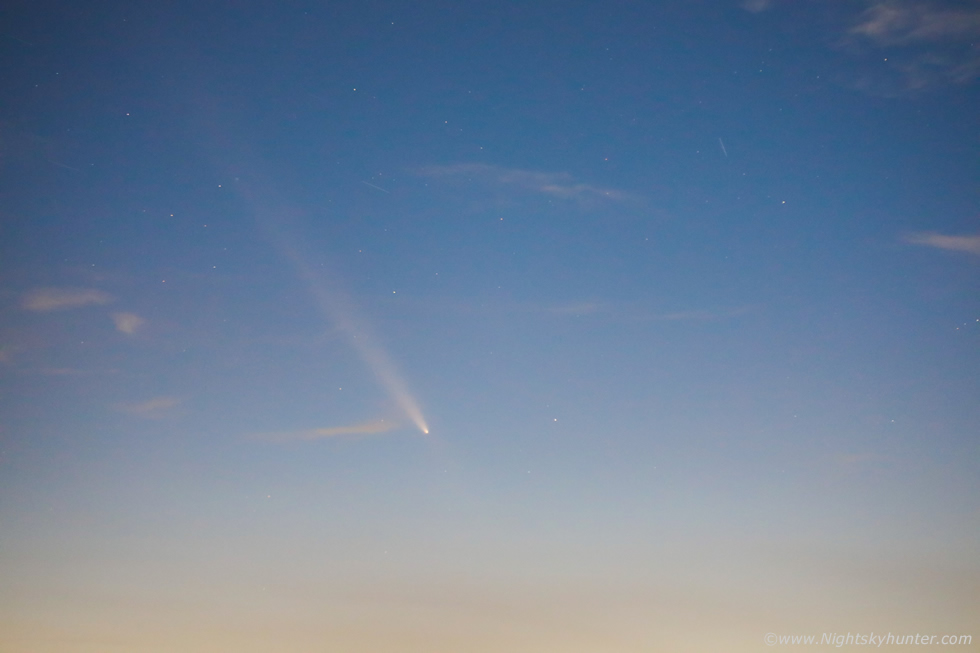 |
At 19.30 I was hopelessly scanning with the binos when I set them down and looked up with the unaided eye and there was a comet!, I had actually found it by eye first, this really shocked me, I was taken back by how much higher it was in the sky, located to the lower left of Arcturus. I trained the binos on the comet and could see its bright fuzzy coma and streaming to the upper left was a long ghostly dust tail pointing to the NE, I was instantly filled with awe and a great sense of relief, finally the comet and I had encountered one another. I turned the 100mm lens in that direction and began taking exposures. The comet was still in bright twilight yet I was picking it up with a 0.5 sec exposure. The dust tail filled a large portion of the frame and when I previewed the image I could see an anti-tail pointing down towards the sun, this was amazing.
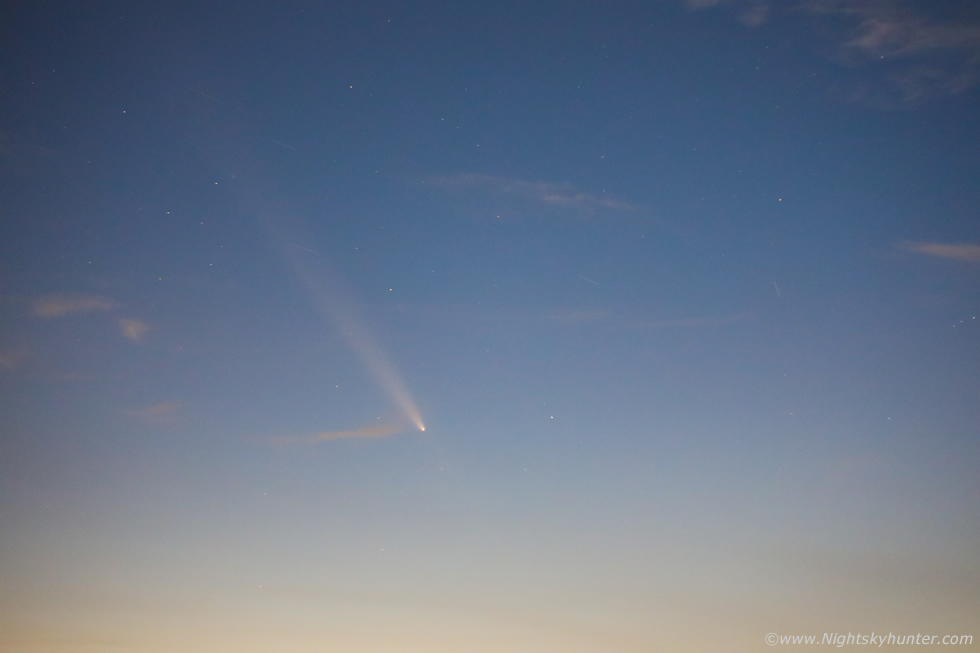 |
I looked up and at a casual glance I could see 15 degrees of naked eye tail. I began shooting a time lapse with both cameras and alternated between using the binoculars and telescope to treasure the visual experience. In the scope the coma was moderately condensed at DC:7, the comet looked around mag +1.0 with a bright central condensation. The comet was so big the telescope didn't really do it justice, the tail seemed to extend into infinity.
 |
The twilight had darkened some more and now I could easily see 20 degrees of naked eye tail or 40 apparent full moon diameters!, the visual scene was like that of a search light beam extending upwards, the tail was white, phantom-like and broadened with distance away from the coma, the latter had a yellow-orange colour due to reflected sunlight. This was the longest naked eye dust tail I had seen since Hale-Bopp in 1997!
I can't express how grateful I felt, all that planning and obsessing for just under two years, all that energy, excitement, anticipation and nerves had all converged on this very moment. A night I thought would be cloudy and now I was standing on the top of a mountain in great clarity watching this naked eye comet. C/2023 A3 Tsuchinshan-ATLAS was a beauty, I felt like I was floating, part of a dream, a great sense of purpose and in the flow, this was what I do, what my life was all about. If I had time I might have got emotional but with strips of cloud approaching I had no time to think, just to react. I was not only happy I was seeing it but getting images too, at least I had a digital record, my plan was to keep time lapsing then when the comet got lower I could frame it with the horizon for a perfect scenic finale. If you stand back from the screen and relax your eyes you can see the anti-tail merging into a low bank of misty cloud, still sporting residual colours from the that sunset afterglow.
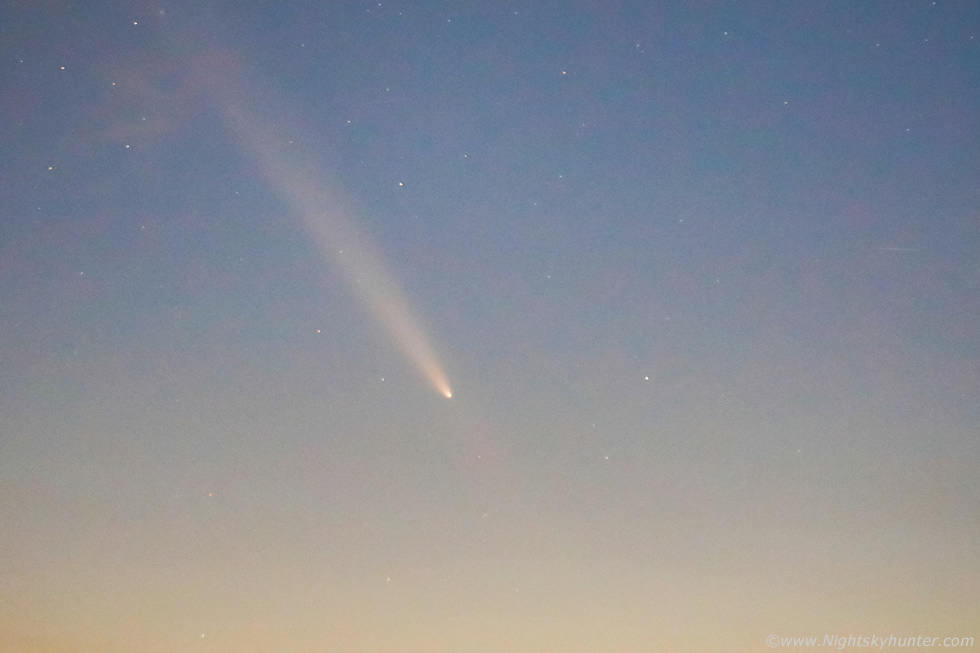 |
This a crop very heavily contrasted showing the anti-tail. This was only two nights after closest Earth approach so the comet was not far of its brightest magnitude as seen against a twilight sky. Forward scattering due to the phase angle geometry was still causing a surge in brightness caused by sunlight reflected and scattered through dust particles in the coma and tail, this happens when the comet is more or less between Earth and the Sun, maximum phase angle was 173 degrees when passing through the SOHO field.
As I looked up my view was getting interrupted frequently with passing cloud and fog blowing across the summit, at times in front of me and other times through me. It was like a dark wall which would come out of nowhere and the comet would be lost from view, then the darkness would thin and I would see it for a few seconds, then darkness again, then 10 sec's of sublime viewing then darkness again, the comet was playing peek-a-boo through the clouds. This dust tail is composed of silicates which get ejected from the icy nucleus via geysers called jets. Solar radiation pressure blows the dust particles behind the nucleus which then trail behind the comet. This dust trails behind the nucleus and follows the comet's orbital path around the sun, the actual tail is millions of miles in length. When you see a meteor (shooting star) in the sky you are actually seeing a tiny dust particle that was once in the tail of an ancient comet.
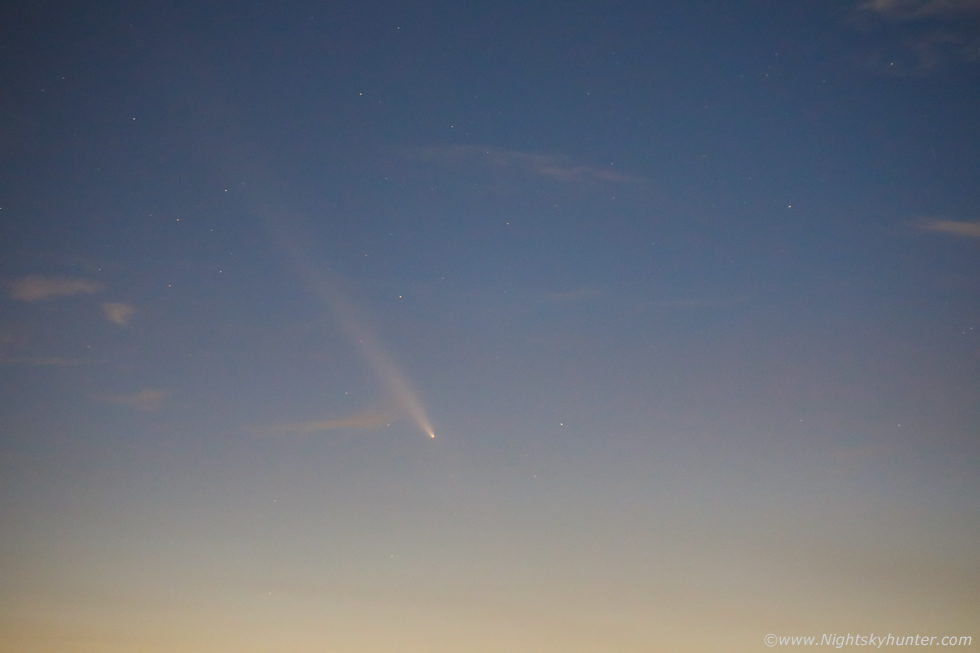 |
One of the 50mm images on crop sensor. I heard a commotion from the Father and Son on the other side of the van and walked over for a look. The Father had found the comet, but not only that he had held up his mobile phone and snapped an image of it and it was better than any image I got, it was a stunning scene. I was impressed that this guy brought his young Son up the mountain to witness this comet. That boy will always remember this moment for the rest of his life, the connection with his Dad, and you never know, he might even develop an interest in Astronomy, and perhaps even become obsessed with comets in later life.
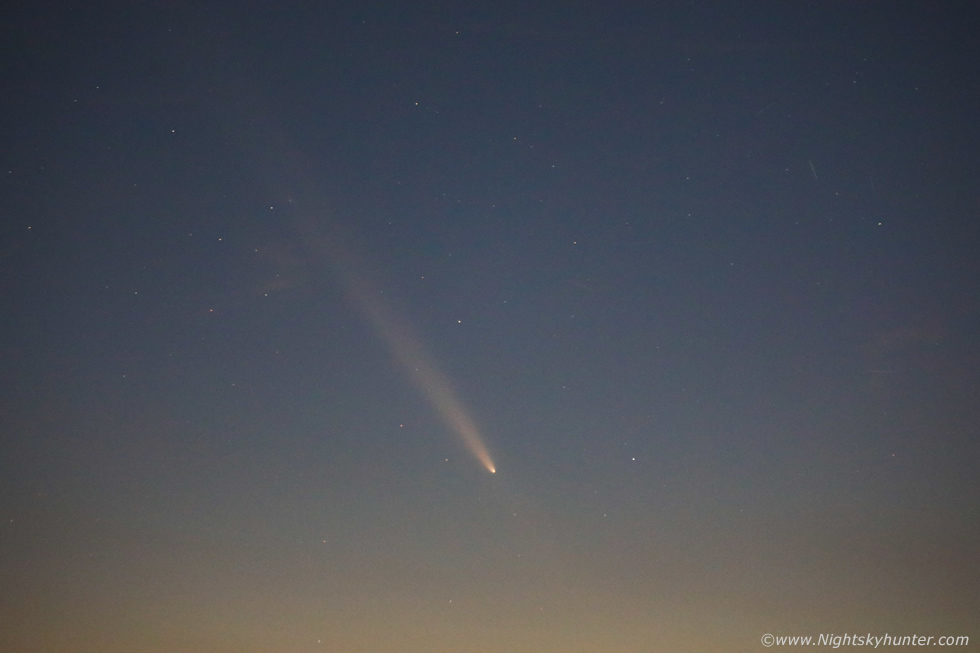 |
My scope and binos were dripping with dew however my camera lenses were fine as I had hand warmers attached and they were doing their job perfectly keeping my optics free from dew. The sky darkened further, I was still only taking short exposures of 1 second. Tonight was the night when the Earth passed directly through the orbital plane of the comet, as a result of this Earth-Sun-Comet geometry the dust tail appeared edge on, but the anti-tail was also of maximum length. Unlike the classic dust tail which more or less points away from the sun the anti-tail points directly towards the sun, this is an optical effect caused by the curving dust tail appearing to project ahead of the coma. The most famous anti-tail in history was displayed on comet Arend-Roland of 1957, I would argue that the anti-tail on C/2023 A3 T-A was just as good if not better.
Just to give you some perspective, can you see the anti-tail extending all the way down to the bottom of this image?, that's at least 5 degrees, however in reality that sunward tail is going all the way to the horizon, passing below the horizon and crossing the sun filling the 15 degree field of view of the LASCO C3 camera on SOHO. If you could switch off the sky glare this anti-tail would be somewhere between 30 and 45 degrees in length.
When you look at a comet it's very important to have an understanding of what you are seeing and only then does the majesty of these objects sink in. These are remnants from the formation of the solar system, comets were born before the planets and most certainly before any life developed on Earth so we are looking at ancient bodies 4.5 billion years old. Due to the fact they they formed from the early solar nebula before they got 'processed' these icy worlds store the chemical secrets of the early solar system, in deep freeze. C/2023 A3 is a long period comet on a highly eccentric orbit, it's true period is unknown, the comet was once in the Oort cloud so far away that no telescope in existence could see it, so far it was almost half way to the nearest star. Something happened, the comet was dislodged from its slumber, likely a gravitational jolt from a passing star which sent it falling inward towards our sun, this journey could have taken millions of years.
Once a comet approaches the sun the gases sublimate and dust jets switch on which form the comet's tail, this is when a comet flourishes in the heat of the sun like a basking Whale, and us observers on Earth rush outside with our telescopes and cameras to view it. On the night I captured it on camera the comet was moving at 70km/sec relative to Earth, think of an icy mountain over 2km in size moving at 70 times the speed of a bullet. It's a good job it didn't hit us which brings us onto our next understanding of a comets role in the solar system. From time to time comets hit planets and the moons of the planets, when they do they cause mass extinctions and alter the course of evolution, I see them as double edged swords with the power to destroy mankind in the future (that will happen) but they also seeded the early Earth with the building blocks of life, rich organic material, CHON particles, comets may have introduced the first stirrings of life on our planet and they may also have contributed to the formation of our oceans. So when you see a comet you are literally looking at your own ancestors!
Back on the mountain the wind was picking up and cloud and fog turned thick and dark, I never saw the comet again. However I can't complain, I seen it at its best and got it on camera and I felt truly grateful for that experience. Had this night been clouded I never would have seen it in all it's glory at all. This was also Rhua's first bright comet, it was cool that she was there with me for the memories. I found out that most of my mates had seen the comet too and they got fantastic images so the night was a total success. When I arrived home I was buzzing, Roisin could see the relief on my face and was happy for me. I had only one complaint though, I never had a chance to get any foreground in the frame to provide a sense of scale, this annoyed me a great deal but I ran out of time when that cloud and fog arrived so there was nothing I could do, but at least I got images. On the other hand the time lapse sequences I shot turned out very well so I was delighted with that. I felt much more at ease now but I just needed a few more clear nights to catch it as it faded.
Filming A Comet With BBC
Skies looked to clear on the evening of October 18th and arrangements where made with the producer of 'Chronicles In The Sperrins' to meet up do our night filming session with the comet at a place called An Creagan. The comet was fading fast and the moon was still very bright but we decided we would dedicate an evening to it on the next available clear evening. Matt, one of the show's main cameramen, would join me from Co. Down and my mate Paul Martin would be joining us for the shoot from Omagh.
A nasty cold front had crossed the country bringing heavy rain and gusty winds with an embedded squall line, however in the wake of the front clear skies where expected to move in from the W after sunset and this was supported by satellite imagery. At 18.00 and I left Cookstown and headed out the Omagh road, cloud at the rear of the front was lit into nice warm colours from the sun breaking out and the scene was complimented by a nice primary and secondary rainbow. Soon the sun had set and Matt and Paul and I grabbed out gear and headed off to the board walk which covered this ancient bog land.
The view was perfect, we had a line of pine trees to the SW-W and given enough time the comet would set over those trees. My goal was to get images and at least one time lapse. I was shooting with the Canon 600D at 50mm and Canon 5D Mark IV at 100mm, I was also observing with 10x42mm binos. Matt had also set up a time lapse using a mirrorless camera and Paul was shooting a time lapse too so all three of us were ready for the comet, we just needed to see it first.
I began to get a little nervous, the sky was clear low in the W but the wind had dropped light and it seemed the residual cloud behind the front was slow moving and dragging it's heels. The cirrus seemed to be rite over the comet, then Paul spotted it in his binos then with a little patience we waited for the Earth's rotation to bring the comet further down into that clearance, within 15 min's our patience was rewarded and its tail stood out on camera with ease. We all set up our compositions and let the cameras roll.
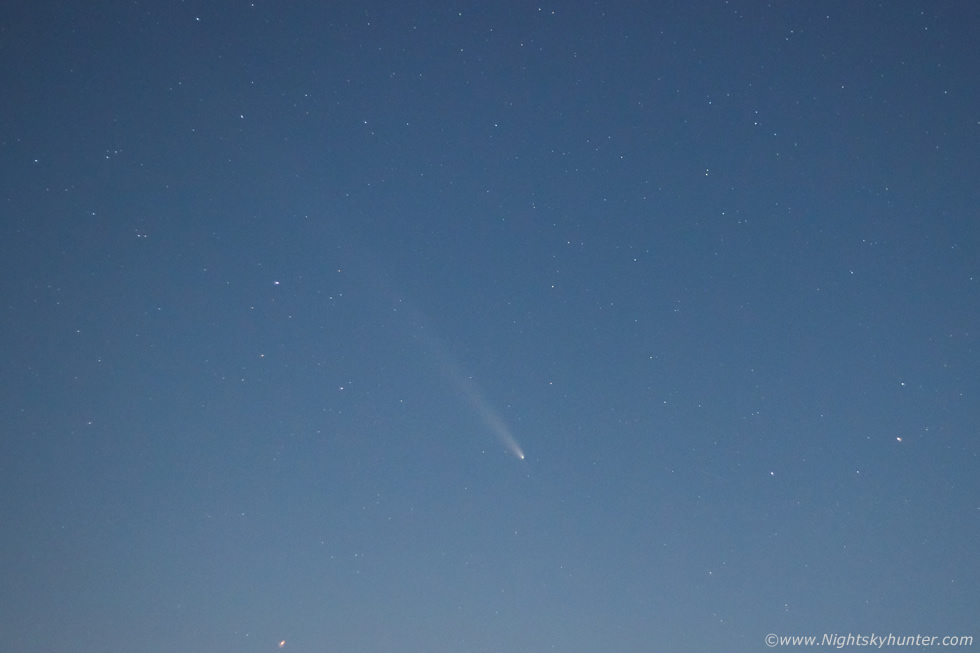 |
Despite the moon being only one day after full, and behind cloud, the comet was still quite impressive in the binos, the ghostly dust tail spanned at least two fields of view and was gorgeous to sweep through. Then when I got my self settled and fully dark adapted I could see the comet with the naked eye, when first spotted it looked like a faint white streak, almost like a stationary ion train from a meteor which never dissipitated. I was amazed to see 10 degrees of dust tail with averted vision, it was strange as the dust tail looked brighter than the coma, I estimated the comet's magnitude at between +4.0 and +4.5.
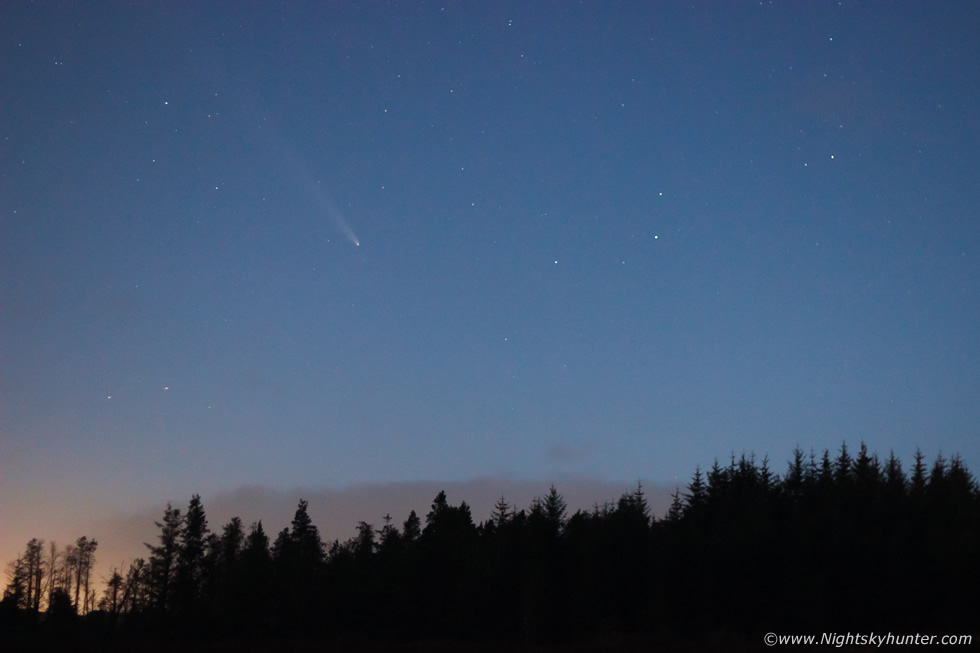 |
We ended up having such a good session standing on this ancient ground taking images, visual observing, and talking about comets and auroras, this also was Matt's first comet which was nice to see. Paul got his DJI Mavic 3 Pro in the air and amazingly managed to get images of the comet at wide angle and with the 70mm lens, that was a first. Quite possibly the first proper image of a comet by drone from N. Ireland, all three of us were buzzing look at the images on Paul's controller screen.
Then we began a second time lapse sequence, this time the comet had lowered enough to be framed with those distant tree tops, this was exactly what I wanted, foreground. If I could get this on time lapse, even for a short period I would be well chuffed. We did, later clouds blew back in and hid the comet's departure over the trees however we got the entire sequence captured before that so the filming session was a complete success. If anyone is interested Chronicles Of The Sperrins will be featured on television during Winter 2025 and will also be available to watch on BBC Iplayer. This comet hunt will be featured in the Autumn episode.
C/2023 A3 is fading fast, it's receding from both the Earth and the Sun at high velocity and the forward scattering enhancement is all but gone. The comet should drop below naked eye visibility soon however I expect it to be a nice object in binoculars and on camera for another week. I look forward to the waning moon and the return of darker skies to see it once again and say farewell to this beautiful visitor. I may image it again, I may not, but I do plan on doing visual observations of it through the telescope over the next week.
Farewell Tsuchinshan-ATLAS
It never cleared again until October 26th when a proper clear night was forecast. The comet was moving further from the Earth and Sun and fading but was still worth seeing and this time the moon would be absent and the sky dark, actually this would be the first time I could observe this comet against a proper dark sky background. I knew it was starting to get beyond the range of my equipment but to be honest with you I wanted one last look at the comet to say farewell, also since all the previous sessions seemed rushed I was after a different experience, a peaceful slow paced one on one communion once again, only this time the comet would be much higher in the sky and hence visible for longer, I would be able to study it at my leisure. Even though getting a few more images for the record was a must, it wasn't important. I wanted to see the comet in the telescope properly, this session would be a visual experience.
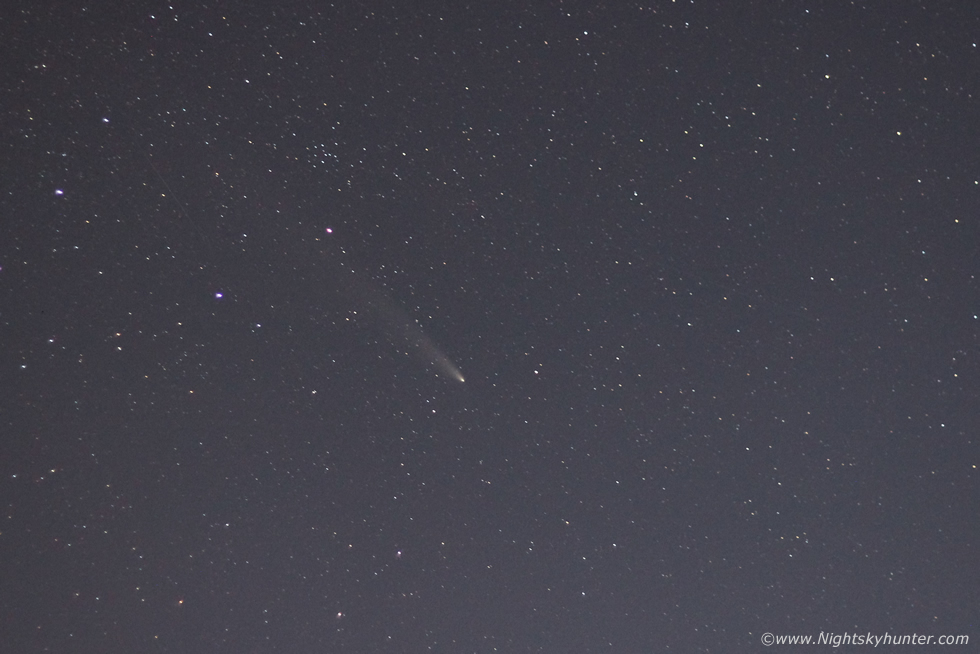 |
I drove past Beaghmore Stone Circles in Co. Tyrone and pulled over at the side of the road. It was just after 19.00 and the sky still had some lingering twilight, the comet was well placed one quarter of the way up the SW evening sky within the NE sector of Ophiuchus the Serpent Holder and in close proximity to naked eye stars. I got dark adapted and held up the 10x42mm binos and did a scan through that area and found the comet within five seconds, when I saw it I was shocked. I was expecting a subdued object yet through the twin eyepieces the comet was absolutely gorgeous, this was a proper comet clearly still putting on a show, the tail filled several binoculars fields even at a casual glance.
Then I took a look with the naked eye and with averted vision I could see it as a faint fuzzy star at mag+5.5, perhaps a fraction brighter, I also could see 4 degrees of naked eye tail, the view was like a faint streak, I was amazed to see it at all. Before I could settle I walked into a field and took one image with the 50mm F/1.8 on my 600D crop sensor, ISO1600 for 8 sec's. The comet stood out easily with its tail passing below a nice open cluster from the NGC catalogue.
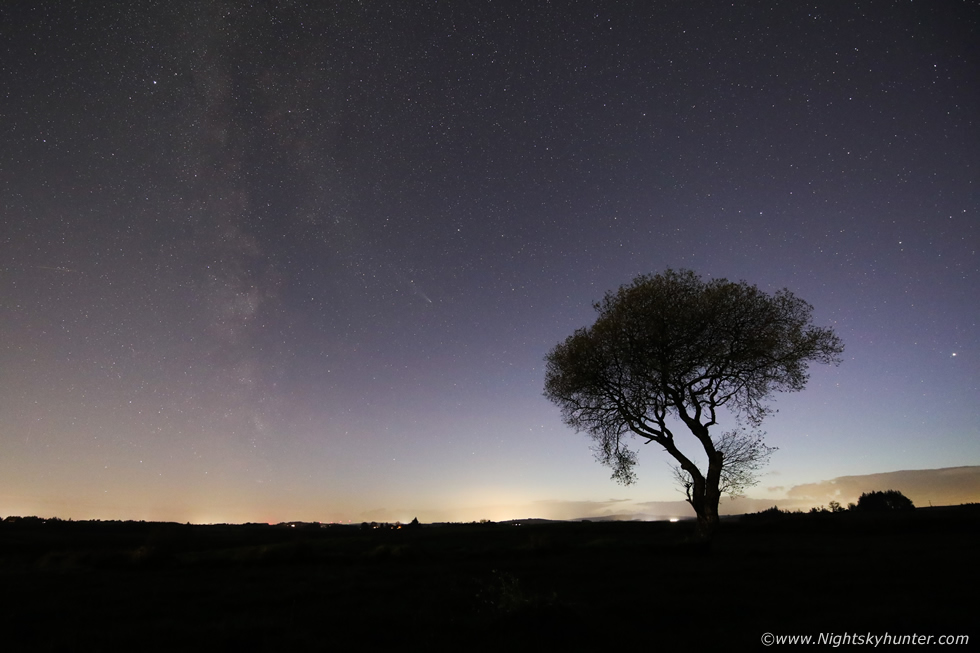 |
I set-up the 5D Mark IV with 15mm F/2.8 lens and shot a time lapse of the Milky Way and comet over the fairy tree. As you can see with such a wide angle lens the comet looked like a faint streak at image centre. I wanted it with the Milky Way which is why I went wide, the structure in our galaxy was brilliant this night. I let the camera shoot then made my way back to the van and set-up the Meade 10" F/5 reflector for the visual experience I had been craving so much. I couldn't have asked for better conditions, the sky was exceptional after a passing front with great clarity and very dark. I let myself adjust to the night by using the scope to observe M13, M92, M11, M57, M56 and Veil Nebula, all of these objects looked ten times better than when I observe them from home, they jumped out of the sky, that's how good the atmosphere was this night.
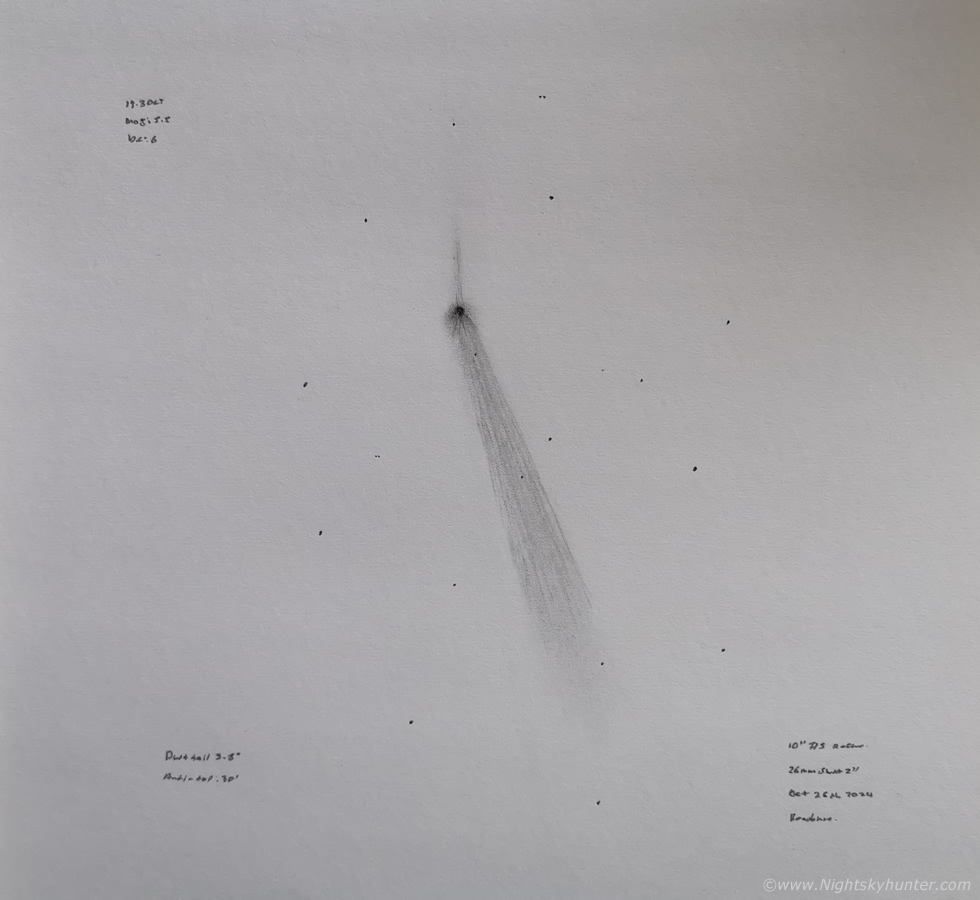 |
I then guided the scope to the SW and placed the telrad where I thought the comet would be and looked into the eyepiece, and there it was. I was blown away, the comet was absolutely gorgeous!!!!, actually it was breathtaking, it looked like a great comet in miniature form. The comet looked alive as if it was some kind of living entity perched against a background of stars. The coma was well defined, rounded, the sunward portion had the classic parabolic shape, you could tell the solar wind was pushing gas and dust downwind. The condensation surprised me, it took the form of a very bright white star, a star with diameter, and just at the limit of vision I observed one or two irregularities from inside that condensation, likely jets. Extending downwind from the coma was a subtle spine and fanning outward were features which looked like streamers.
The dust tail was beautiful, very bright, high surface brightness, uniform, and smooth in profile with well defined edges, it fanned outward with distance. The tail was grey-white however I could also make out a blue tint within which was likely the ion tail coming through, both tails where superimposed on one another. I could track the dust tail for 3.5 degrees in the 26mm SWA FOV before it faded away into nowhere at the limit of vision. I placed the coma at the E side of the FOV then let the comet drift across the field due to the Earth's rotation, it was a remarkable sight from this dark location, I kept saying ''Jes*s'' over and over, the visual spectacle surpassed what I had hoped for. At last I got the experience I wanted, this was the perfect fare well. Then when things couldn't get any better I glimpsed the anti-tail, it was still there!, it was pointing towards the sun, it looked to be at a position angle off-axis from the dust tail, one edge was sharp and well defined, I could see subtle material fanning down from that too which blended into the background sky. I tried my best to convey this in the sketch above.
I was happy, I took a break and went back into the field to get my camera when I saw a faint aurora to the N/NW, no beams, just an obvious auroral glow, I took one exposure with the camera and sure enough the sky had a red aurora with faint rays, that was icing on the cake. What a successful night this had been with the comet, Milky Way and aurora all at the same time. I had got the experience I had wanted. I'm now at peace with C/2023 A3 T-A, I wished the comet well as it sailed outbound into the icy darkness of space with a destination somewhere beyond our solar system, no living creature may ever see it again.
Comet Overview
So how did C/2023 A3 perform? - this comet behaved itself perfectly and lived up to the hype, its brightness evolution and dust tail dynamics were all successfully forecast with a high degree of accuracy, the comet stayed on the brightest prediction of the light curve and remained healthy and intact, it was an exceptional example of a classic long period comet.
Was C/2023 A3 a Great Comet? - there's currently some debate on this rite now, a few voices strongly advocate this reached great comet status, however I don't agree. A great comet is very subjective however I think its quite obvious when a comet has reached that status or not. A3 was bright, mag -4.9 in SOHO, and negative magnitude in evening twilight, however it did not jump out of the sky at a casual glance to members of the public. It didn't compare with McNaught, Hyakutake, Hale-Bopp or WEST. This doesn't take anything away from the comet at all, C/2023 A3 was a beautiful comet! and our brightest here in 27 hears since Hale-Bopp, that's some feat, there's no question this was our best naked eye dust tail from the northern hemisphere. In my mind's eye now I can still see that search light beam hanging in the evening twilight at a 45 degree angle dominating the sky, a memory I will never forget.
C/2023 A3 T-A vs C/2020 F3 NEOWISE - I've seen people making comparisons between these two comets. This is my stance on it, I don't think its fair comparing one naked eye comet with another, it's like comparing a Ferrari with a Lamborghini, both are great, yet both comets have their own particular traits which make them stand out. Some have said NEOWISE was better, I don't agree but lets take a look at the pros of each comet.
NEOWISE took us by surprise, it performed better than expected and had a nucleus 5km in diameter. It exhibited a broad and slightly curved dust tail complimented by a fainter blue ion tail, I think the reason why this comet is so potent in everyone's minds is because it was the first obvious naked eye comet in the northern hemisphere. Also it appeared in Summer so I associated it with short twilight nights which were mild so good memories. The comet also appeared at the end of the pandemic so it was literally like a ray of sunshine in the darkness, something exciting to keep our heads up and lift our hearts. NEOWISE also appeared embedded within NLCs, that in itself makes this comet a once in a life time event. For me the most stand out feature was the golden coma and gold tail, I consider the view in my 8" scope to be one of the most gorgeous sights I've ever seen in nature.
C/2023 A3 had a big build up, an intense up and down roller coaster ride long before it even appeared which added to the anticipation. The nucleus is 2.3km in diameter however it was extremely dust rich and active along a large portion of its surface. A3 approached closer to the sun than NEOWISE and as such it was imaged in broad daylight. A3 exhibited significant forward scattering which caused an 800 fold increase in brightness.
Without question A3 sported the longest and brightest naked eye dust tail on any comet since 1997, so this ranks it high on my list. The most unique aspect of this comet was it's anti-tail spike which was the longest since Arend-Roland of 1957, in fact, it may have the longest anti-tail ever recorded in modern times. This comet was big and bright however the most spectacular part of its appearance only happened during a short period of time, October 12th to the 15th say, if you were clouded out around this time then you missed the comet at its finest.
Another noteworthy consideration for ranking A3 is its timing with solar maximum while approaching Earth in conjunction with a high velocity CME. The aurora we witnessed on October 10th was a sight to behold, simply jaw dropping and beyond description, I felt like dropping to my knees in surrender to this incredible display of nature at her absolute finest. Then a few nights later to have a naked eye comet with long tail was just the icing on the celestial cake, this comet will be remembered for this very special time, this was an October when dreams really did come true.
While on the subject of bright comets here are links to a few more comets I've chased in recent times which required extensive reports...
C/2021 A1 Leonard
http://www.nightskyhunter.com/Comet%20Leonard.html
C/2020 F3 NEOWISE
http://www.nightskyhunter.com/Comet%20NEOWISE%20From%20Northern%20Ireland%20-%20July%202020.html
C/2006 P1 McNaught
http://www.nightskyhunter.com/Observing%20Comet%20Mc%20Naught.html
I do have a few regrets, not being able to do the comet justice on camera or including foreground elements on its best night so I feel I haven't contended myself in the photographic compartment. This was not the comet's fault but pure chance due to location and weather, my views of it were fleeting but from what I seen of it I was impressed and I feel gratitude for having that special communion with the comet on October 14th, this was the night I will always be talking about for years to come. C/2023 A3 has brought to an end our long comet drought in the northern hemisphere, sometimes comets are like buses and two come along at once, remember 1996 and 1997, so perhaps the tables have turned and our long wait is over. If we keep our hopes high another bright comet could get discovered soon and perhaps even a great comet is on its way, just waiting to be discovered any night now. So until then, the hunt for the next bright comet continues. Thanks very much for reading, especially if you made it this far!
Martin McKenna